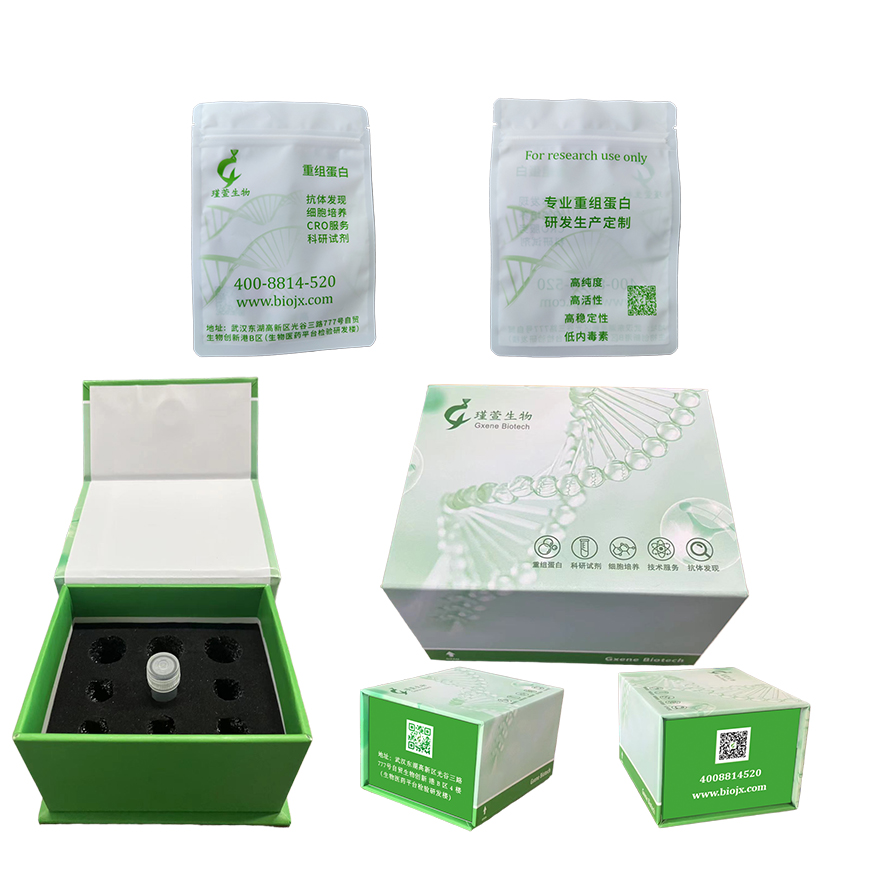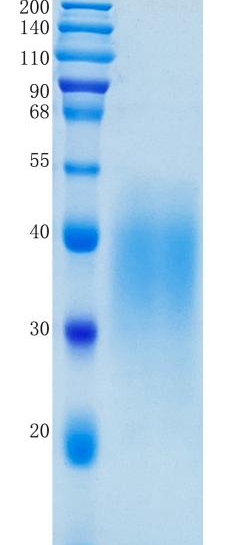研究方向
干细胞因子(SCF)也称为肥大细胞生长因子(MGF)和钢因子(SLF),在配子发生、黑素生成和造血早期阶段发挥重要作用。SCF是一种二聚体分子,通过结合并激活受体酪氨酸激酶c-Kit来发挥其生物学功能。
生物活性
Measured in a cell proliferation assay using TF‑1 human erythroleukemic cells. The ED50 forthis effect is 1.00-8.00 ng/mL.
种属
Human
表达宿主
HEK293 cells
Calculated MW
21.89 kDa
Observed MW
35-38 kDa
标签
C-His
纯度
> 97% by SDS-PAGE.
内毒素
< 0.1 EU/μg of the protein by LAL method.
制剂
Lyophilized from a 0.22 μm filtered solution of PBS, pH 7.4.Contact us for customized product form or formulation.
描述
Recombinant Human c-Kit ligand/KITLG/SCF Protein is produced by HEK293 cells expression system. The target protein is expressed with sequence (Glu26-His214) of human SCF/C-kit ligand (Accession #NP_000890.1) fused with a 6×His tag at the C-terminus.
储存
Store at -20℃.Store the lyophilized protein at -20℃ to -80 ℃ up to 1 year from the date of receipt.
After reconstitution, the protein solution is stable at -20℃ for 3 months, at 2-8℃ for up to 1 week.未开盖的干粉蛋白在 -20°C至-80°C可保存12个月;
复溶之后,蛋白溶液在-20°C及以下可保存3个月,在2-8℃可保存1周。
After reconstitution, the protein solution is stable at -20℃ for 3 months, at 2-8℃ for up to 1 week.未开盖的干粉蛋白在 -20°C至-80°C可保存12个月;
复溶之后,蛋白溶液在-20°C及以下可保存3个月,在2-8℃可保存1周。
复溶
Centrifuge the vial before opening. Reconstitute to a concentration of 0.1-0.5 mg/mL in sterile distilled water. Avoid vortex or vigorously pipetting the protein. For long term storage, it is recommended to add a carrier protein or stablizer (e.g. 0.1% BSA, 5% HSA, 10% FBS or 5% Trehalose), and aliquot the reconstituted protein solution to minimize free-thaw cycles.收到重组蛋白产品之后请检查蛋白冻干粉末是否贴于瓶底,如果粉末浮起,开盖之前请先低温离心。将蛋白用说明书中指定的缓冲液复溶至0.1-0.5 mg/mL(请注意蛋白复溶浓度不能低于0.1 mg/mL),室温平衡5-10 min保证充分溶解,复溶过程中请不要剧烈涡旋及吹打蛋白溶液。如需长期储存,建议复溶时添加载体蛋白或者稳定剂(如0.1% BSA, 5% HSA, 10% FBS 或者 5% 海藻糖),同时将复溶后的蛋白溶液按照需求进行分装,储存于-20°C至-80°C,随取随用,避免反复冻融。
背景信息
The protein is tyrosine-kinase receptor. This ligand is a pleiotropic factor that acts in utero in germ cell and neural cell development, and hematopoiesis, all believed to reflect a role in cell migration. In adults, it functions pleiotropically, while mostly noted for its continued requirement in hematopoiesis.


